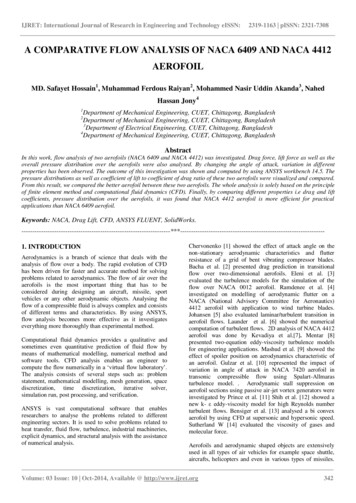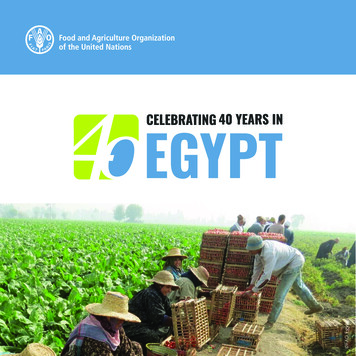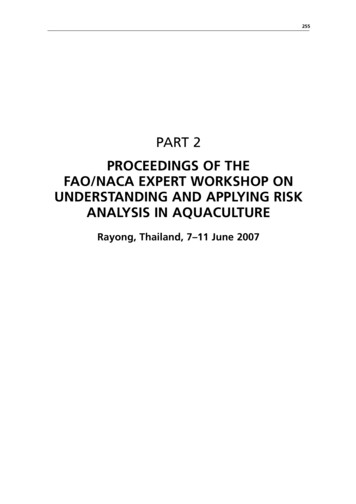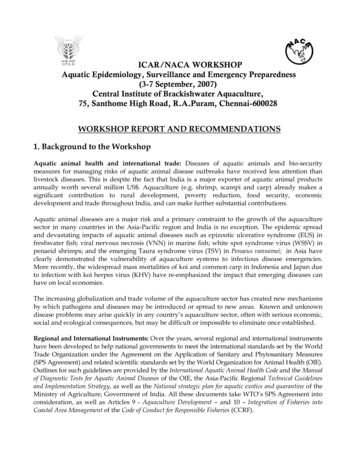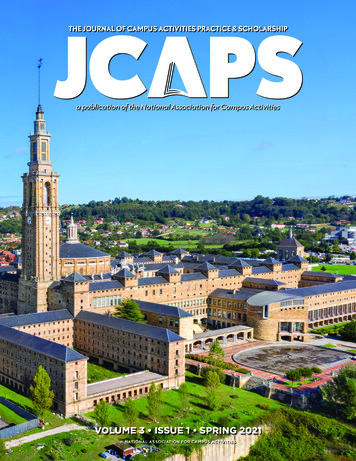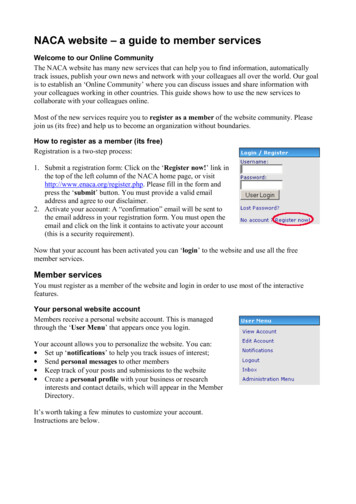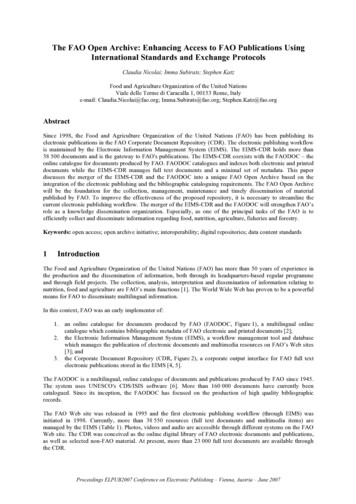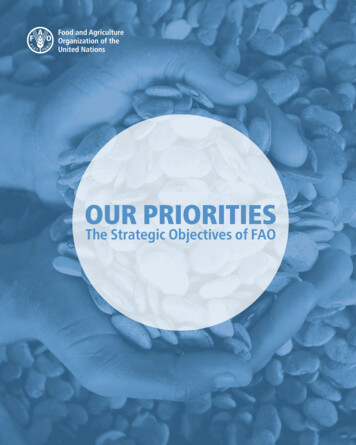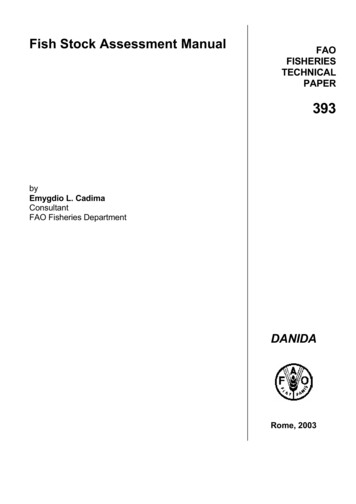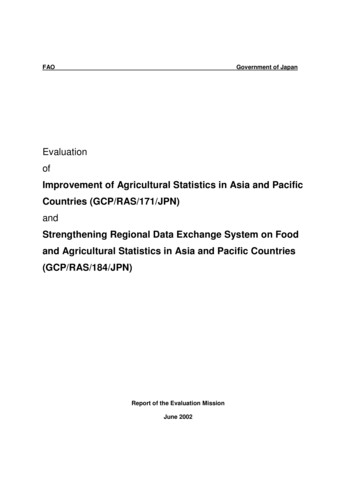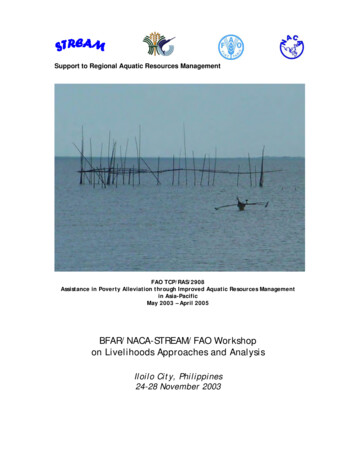
Transcription
Support to Regional Aquatic Resources ManagementFAO TCP/RAS/2908Assistance in Poverty Alleviation through Improved Aquatic Resources Managementin Asia-PacificMay 2003 – April 2005BFAR/NACA-STREAM/FAO Workshopon Livelihoods Approaches and AnalysisIloilo City, Philippines24-28 November 2003
STREAM 2003 Report of the BFAR/NACA-STREAM/FAO Workshop on Livelihoods Approachesand Analysis, Iloilo City, Philippines, 24-28 November 2003. Bangkok: NACA-STREAM.43 pp. ISBN 974-91889-5-0.
Assistance in Poverty Alleviation through Improved Aquatic ResourcesManagement in Asia-PacificBFAR/NACA-STREAM/FAO Workshopon Livelihoods Approaches and AnalysisIloilo City, Philippines24-28 November 2003FAO TCP/RAS/2908May 2003 – April 2005
BFAR/NACA-STREAM/FAO WORKSHOP ON LIVELIHOODS APPROACHES AND ANALYSISContentsBoxes, Figures and TablesAcronymsAcknowledgementsExecutive SummaryiiiivvviIntroduction1ContextPurpose and ObjectivesInputs, Outputs and Outcomes111Day One3Opening CeremonyOpening RemarksWelcome AddressMessagesIntroduction of ParticipantsExperiences and ExpectationsBanate Bay TeamSapian Bay TeamEC-PREP TeamOverview of the Workshop and Monitoring and EvaluationIntroduction to NACA-STREAM, FAO, BFAR and EC-PREPWhat are ‘Livelihoods’ (Approaches, Analysis)?Teams and StakeholdersDay Two3333455556681011Expectations RevisitedLearning about and Understanding Livelihoods – Livelihoods Frameworks andApproachesLivelihoods Analysis – Processes, Practices, Studies, Languages and StoriesPreparation for Community Visit – Roles and Tools for Learning andCommunicating about LivelihoodsDay Three1111111215Community Visit15Day Four16Community Visit ReportbackEC-PREPSapian BayBanate BayTowards a Draft Guide for Livelihoods Analysisi1616161718
ASSISTANCE IN POVERTY ALLEVIATION THROUGH IMPROVED AQUATIC RESOURCES MANAGEMENT IN ASIA-PACIFICDay Five19Language(s), Power and RelationshipsBanate Bay TeamEC-PREP TeamSapian Bay TeamPlanning Activities for Livelihoods Analysis and Follow-Up ActionsThinking about M&E and Significant ChangeEvaluationClosing aft ProgramParticipantsReportback on Teams and StakeholdersEC-PREP Community Visit ReportbackSapian Bay Community Visit ReportbackGuide for Livelihoods Analysis Draft OutlineSignificant Change Storiesii23313234384041
BFAR/NACA-STREAM/FAO WORKSHOP ON LIVELIHOODS APPROACHES AND ANALYSISBoxes, Figures and TablesBox 1Sharing Understandings8Box 2Teams and Stakeholders10Box 3Expectations12Box 4Community Visit Purpose14Box 5What makes people comfortable enough to talk?19Figure 1Institutions, Projects and Funding Agencies Linked in the WorkshopFigure 2A Livelihoods Framework from Banate Bay Team13Figure 3A Livelihoods Framework from Sapian Bay Team13Figure 4Images from the Talokgangan Community Visit15Figure 5Problem Tree of Barangay Talokgangan Community Elders17Table 1Sharing Understandings of ‘Livelihoods’Table 2A Livelihoods Framework from EC-PREP Team14Table 3Communication Issues among Stakeholder Groups20iii79
ASSISTANCE IN POVERTY ALLEVIATION THROUGH IMPROVED AQUATIC RESOURCES MANAGEMENT IN ASIA-PACIFICAcronymsBBRMCIBFARBFAR KSAL&LLao RRAPOROSPARKSTREAMTCDCTCPUKUPVFI-FRMP6Banate Bay Resource Management Committee IncorporatedBureau of Fisheries and Aquatic ResourcesBFAR Central OfficeBarangay Fisheries and Aquatic Resources Management CouncilCommunity OrganizationCivil Society OrganizationDepartment of AgricultureDepartment of Environment and Natural ResourcesDepartment for International Development (UK)Department of Social Welfare and DevelopmentDepartment of Trade and IndustryEuropean Community Poverty Reduction Effectiveness ProgrammeFisherfolk AssociationFood and Agriculture Organization of the United NationsFisheries and Aquatic Resources Management CouncilsFarm to Market RoadKnowledge, Skills and AttitudeLanguages and LivelihoodsLao People’s Democratic RepublicLocal Government UnitLivelihood Needs AssessmentMonitoring and EvaluationMarine Aquarium CouncilMunicipal Agriculture OfficeMunicipal Fisheries and Aquatic Resources Management CouncilMemorandum of AgreementMinistry of Social Welfare and Development (now DSWD)Network of Aquaculture Centres in Asia-PacificNational Government AgencyNon-governmental OrganizationObjectively Verifiable IndicatorPhilippine Partnership for the Development of Human Resources in RuralAreasPeople’s OrganizationRegional OfficeSharing and Promotion of Awareness and Regional KnowledgeSupport to Regional Aquatic Resources ManagementTechnical Cooperation between Developing CountriesTechnical Cooperation ProgramUnited KingdomUniversity of the Philippines in the Visayas Foundation IncorporatedFisheries Resource Management Project in Region 6iv
BFAR/NACA-STREAM/FAO WORKSHOP ON LIVELIHOODS APPROACHES AND ANALYSISAcknowledgementsThe success of this workshop was due to the involvement and participation of severalindividuals and groups. We would like to acknowledge the assistance and support of: FAO for funding the Technical Cooperation Program and for their commitmentto improving the lives of rural and coastal poor people through their povertyalleviation program and the strengthening of on-going aquatic resourcesmanagement policy change processes in the region. The staff of BFAR Region 6 and the STREAM Philippines Country Office, and inparticular Director Sonia V Seville, Erwin L Pador and Elizabeth M Gonzales, forhosting the workshop. The workshop participants, for bringing their experiences and sharing themgenerously with each other. The community elders, fisherfolk, women and young people of BarangayTalokgangan, who gave up their time to meet with the livelihoods teams andtell their stories.v
ASSISTANCE IN POVERTY ALLEVIATION THROUGH IMPROVED AQUATIC RESOURCES MANAGEMENT IN ASIA-PACIFICExecutive SummaryThis is the report of the “BFAR/NACA-STREAM/FAO Workshop on Livelihoods Approachesand Analysis” that was conducted in Iloilo City, Philippines from 24-28 November 2003.The main purpose of the workshop was to develop and document mechanisms for trainingin livelihoods approaches and analysis, and to build national capacity to conductlivelihoods analysis. The workshop in Iloilo was the first in a series which will take place inother countries in the region, including India (with Nepal), Lao PDR, Myanmar and Yunnan,China.The objectives of the workshop were to:Gain an understanding of issues of interest to people whose livelihoods includeaquatic resources management, particularly those with limited resourcesBuild teams of individuals who could do livelihoods analyses and trainingShare understandings and experiences of livelihoods approaches and analysisusing participatory methodsReview current NACA-STREAM livelihoods analysis documentationCommence the drafting of a Guide for Livelihoods AnalysisPlan activities for carrying out livelihoods analyses, andConsider how to build capacity in monitoring and evaluation (M&E) and“significant change”.The week was spent exploring the complex nature of the communities and groups withwhom we work and sharing understandings about how best to learn about their livelihoods.Additionally, adaptations of the tools for learning and communicating about livelihoods –first developed in the “SPARK-STREAM Languages and Livelihoods Workshops”1 were usedto help participants understand livelihoods analysis processes.A central element of the workshop was the community visit to the Talokgangan at BanateBay, where participants conducted activities to learn about the community’s livelihoods.In addition to gaining information about the Talokgangan community itself, participantsalso gained some important insights into how best to conduct livelihoods analyses.One of the main outputs from the workshop is a draft outline for a Guide for LivelihoodsAnalysis, which will be modified through the series of “Workshops on LivelihoodsApproaches and Analysis” throughout the region. The lessons learnt from the communityvisit to Talokgangan fed directly into the drafting of this Guide, and participants also drewon their experiences of the workshop activities to consider what kind of Guide should bedeveloped and what further actions should be taken.It was decided that the Guide should be multi-purpose, multi-audience and practical,providing simple-yet-comprehensive direction for carrying out livelihoods analysis. Itsevolution should be documented through monitoring and evaluation.Follow-up actions from this workshop include the formation of three livelihoods teams, thesetting up of a working group coordinated by STREAM Philippines, and furtherdevelopment of the Guide.1Languages and Livelihoods Phase 1 (Defining the Conversation Group) and the Languages andLivelihoods Tools 1 (Conversation Partners), 2 (Relationships) and 3 (Communication Issues)vi
BFAR/NACA-STREAM/FAO WORKSHOP ON LIVELIHOODS APPROACHES AND ANALYSISIntroductionContextThe “BFAR/NACA-STREAM/FAO Workshop on Livelihoods Approaches and Analysis” is anactivity within an FAO2-funded Technical Cooperation Program (TCP) under the projectentitled “Assistance in Poverty Alleviation through Improved Aquatic ResourcesManagement in Asia-Pacific”. The workshop was organized by BFAR3 Region 6, the hostpartner of NACA4-STREAM’s5 Philippines Country Office. The workshop (draft program inAppendix 1) is part of a series of workshops which will take place in India (with Nepal),Lao PDR, Myanmar and Yunnan, China.The FAO-TCP provides technical assistance to build national and regional capacity inlivelihoods approaches and analysis and to empower a wide range of stakeholders,including rural poor people, through strengthened learning and communications channels,to encourage, support and strengthen on-going aquatic resources management policychange processes in the region.Purpose and ObjectivesRelated to the FAO-TCP outputs, the purpose of this workshop was to develop anddocument mechanisms for training in livelihoods approaches and analysis, and to buildnational capacity. The objectives were for participants to: Understand issues of interest to people whose livelihoods include aquaticresources management, especially those with limited resourcesBuild “(national) livelihoods teams” to do livelihoods analyses and training, andshare their experiences with communities and other stakeholdersShare understandings of livelihoods approaches and analysis using participatorymethodsReview current NACA-STREAM livelihoods analysis documentation, adapt andsupplement, towards the drafting of a Guide for Livelihoods AnalysisExperience the use of participatory tools for livelihoods analysisPlan activities for carrying out livelihoods analyses, andConsider how to build capacity in monitoring and evaluation (M&E) and“significant change”.Inputs, Outputs and OutcomesThe workshop was informed by the learning and documentation which emerged from a“livelihoods workshop-series” in Cambodia and Vietnam, carried out in pre-STREAM2001 by NACA with DFID6 support; as well as by the outputs of other NACA-STREAMrelated livelihoods initiatives such as:2Food and Agriculture Organization of the United NationsBureau of Fisheries and Aquatic Resources4Network of Aquaculture Centers in Asia-Pacific5Support to Regional Aquatic Resources Management6Department for International Development, UK31
ASSISTANCE IN POVERTY ALLEVIATION THROUGH IMPROVED AQUATIC RESOURCES MANAGEMENT IN ASIA-PACIFICA Process and Practice for Understanding the Livelihoods of Fishers andFarmers (from the original CD)Cambodia, Philippines and Vietnam reportsCambodia and Vietnam livelihoods studiesLivelihoods and Languages Workshops reportsGuide to a Process for Learning and Communicating about Livelihoods (draft),andSTREAM Journals.It was anticipated that the first output from this workshop would be a draft outline for aGuide for Livelihoods Analysis, which will be modified through the series of FAO-TCP“Workshops on Livelihoods Approaches and Analysis” in India (with Nepal), Lao PDR,Myanmar and Yunnan, China. The second workshop output would be livelihoods analysisactivity plans.Additionally, the workshop was expected to initiate the formation of groups ofstakeholders [“(national) livelihoods teams”] to look into “livelihoods” as an integral andsustainable development approach. These teams could support organizations and agenciesinterested in implementing a participatory livelihoods approach.The core members of each team are expected to be drawn from the workshop participants(Appendix 2), while the whole team would consist of representatives from: BFAR (national and regional): central office, planning, extension, training andcommunication division, FARMC coordinating unitLocal Government Units (LGU): municipalFisheries and Aquatic Resources Management Councils (FARMC), including executivedirectors of “bay management councils”NGOs, andCommunity leaders of People’s Organizations (PO)For the purposes of the workshop, the participants were grouped into three teams, whichwere based on likely livelihoods analysis locations or informant groups: the Banate Bayteam, the Sapian Bay Team and the EC-PREP Team. These teams worked together duringall the workshop activities and discussions, including the Community Visit.2
BFAR/NACA-STREAM/FAO WORKSHOP ON LIVELIHOODS APPROACHES AND ANALYSISDay OneOpening CeremonyThe workshop opened with a prayer and the national anthem.Opening RemarksSonia V Seville, Regional Director of BFAR 6Sonia welcomed the dignitaries and participants to the workshop. She outlined thepurpose of the workshop and said that she hoped we could pass on what we learned hereto other groups and organizations, not just in this region but in other regions of thePhilippines and in other countries.Welcome AddressNeil D Tupas, Governor of Iloilo Province (represented by Manuel Mejorada, ProvincialAdministrator)“It’s a welcome development that STREAM has come to work with livelihoods as this willhelp members of poorer communities to move away from illegal fishing activities. Thegovernor is also working hard to eliminate all forms of illegal fishing in the Iloilo regionwith some success, as well as working more generally for the conservation of aquaticresources. At present there is a pressure to bring home more fish, so fisherfolk have toresort to using illegal fishing methods. With the banning of fishing in the closed season,people have had to make some sacrifices for a short time. It is important to show thesepeople other livelihoods methods so they don’t have to rely solely on fishing. We arehopeful that what is learnt here is not just applicable to this region, but also to otherswho might benefit.”MessagesGraham Haylor, STREAM DirectorGraham welcomed everyone and stated that as part of STREAM’s work supportingcapacity-building across the Asia-Pacific region, this would be the first in a series ofworkshops which would take place in other countries of the region: India (with Nepal), LaoPDR, Myanmar and Yunnan, China. He hoped this workshop would be a success and augurwell for the rest of the series.Malcolm I Sarmiento, Director of BFAR (represented by Romeo B de Sagun, AssistantDirector for Administrative Services)“Distinguished participants and guests, my colleagues in BFAR Region 6, ladies andgentlemen, a very pleasant morning to you all!First and foremost, on behalf of Director Sarmiento, allow me to welcome you all here inIloilo City to this Workshop on Livelihoods Approaches and Analysis organized by our veryown BFAR Region 6 under the leadership of Director Seville, host partner of NACA-STREAMPhilippines Country Office, in cooperation with the NACA-STREAM Initiative in Bangkok,Thailand. This workshop is part of the FAO Technical Cooperation Program entitled‘Assistance in Poverty Alleviation through Improved Aquatic Resources Management in3
ASSISTANCE IN POVERTY ALLEVIATION THROUGH IMPROVED AQUATIC RESOURCES MANAGEMENT IN ASIA-PACIFICAsia-Pacific’ whose primary aim is to provide technical assistance in building national andregional capability in livelihoods approaches and analysis. This workshop, on the otherhand, aims to discuss and understand better the livelihoods of our indigent brothers andsisters in coastal areas, and develop a guide for livelihoods analysis through active andparticipatory methods.Everyone knows that poverty has been and still is one of the foremost problems besettingour country today. Statistically, it affects a significant portion of the entire populacewhether in rural or urban areas. And the best method employed by the presentgovernment in curbing this perennial problem is through provision of livelihoodopportunities for the needy populace, especially in rural areas by way of various projectsand programs all geared toward poverty alleviation and upliftment of standards of ourpoor fisherfolk.The BFAR, being a service-oriented agency, fully supports the government’s efforts onpoverty alleviation through the implementation of various livelihoods programs vis-à-visaquatic resources management. It is a stated policy in our fisheries code that the stateshall ensure the attainment of poverty alleviation and the provision of supplementarylivelihoods among municipal fisherfolk. For our part, we consider this workshop animportant contribution to these livelihoods programs since it aims to empower participantsby instilling the necessary skills, knowledge and understanding in the area of livelihoodsapproaches and analysis, encouraging a hands-on approach in the process, and to enhancetheir respective capabilities in undertaking support activities to organizations and agenciesinterested in implementing participatory livelihood approaches. Eventually, all livelihoodsprograms and projects will be enhanced with the support of trained people leading theway as a result of this workshop.On a personal note, I encourage all participants to take to heart the purpose andobjectives of this workshop. Learn well and then apply what you have learned when yougo back to your work. I assure you professionally and personally it will make all yourefforts more worthwhile and rewarding. It is the expected output of this workshop, todraft a Guide for Livelihoods Analysis, and the livelihoods analysis activity plans and theformation of groups of stakeholders to look into livelihoods as an integral and sustainabledevelopment approach. I wish to thank BFAR 6 and NACA-STREAM for making this workshoppossible.They say the journey of a thousand miles starts with the first step. This indeed is the firststep towards poverty alleviation. I hope this workshop will be productive and successfulfor the best interests of our poorest of the poor fisherfolk.Good luck and good day to everyone. Thank you very much.”Introduction of ParticipantsJuliet B Demo-os, Assistant Regional Director, BFAR 6Juliet introduced the participants of the workshop and briefly outlined which offices theywere based in. As mentioned above, a list of participants and their team groupings for theworkshop can be seen in Appendix 2.4
BFAR/NACA-STREAM/FAO WORKSHOP ON LIVELIHOODS APPROACHES AND ANALYSISExperiences and ExpectationsAs a way of sharing understandings about the purpose, objectives, inputs, outputs andoutcomes of the workshop, and to find out how familiar participants were with livelihoodsconcepts, participants were asked to discuss their experiences of livelihoods work andtheir expectations of this workshop. These experiences and expectations were presentedback to the group on Day Two as a way of indicating where expectations may be met.Banate Bay TeamExperiences Conducting trainings on livelihoods and capability-building for fisherfolk (most of thegroup)Assisting fisherfolk in acquiring credit assistance, monitoring on-going projects, givinginformation materials, such as flyers to clientele and fisherfolkAssisting in the formulation of strategies to manage resourcesPlaying a part in the enforcement of fisheries laws in their areas, deputized aswardensConducting consultative dialoguesConducting and participating in training for proposed livelihoods projectsParticipating as beneficiaries in such projectsExpectations Learn more about the different approaches to livelihoods and to better understandthem, and to share experiences with othersSapian Bay TeamExperiences Preparation of livelihoods projects as an economic or supplementary activity forfisherfolk, more into technology disseminationLimited experience with livelihoods as a business, for example, prawn, whichtranslates into fisheries extensionLooking into livelihoods opportunitiesLooking into livelihoods in connection with managing and operationalizing cooperativesin the areaExpectations Gain insights into a broader understanding of livelihoodsShift paradigms from short-sighted view of livelihoods to a longer-term viewGet hold of a guide for doing livelihoods analysisEC-PREP TeamExperiences Facilitation of livelihoods projects, training and workshops, group leaders, study tours,among communities and organizationsSurveys of livelihoods of aquarium fish collectorsSustainable livelihoods research5
ASSISTANCE IN POVERTY ALLEVIATION THROUGH IMPROVED AQUATIC RESOURCES MANAGEMENT IN ASIA-PACIFICExpectations Know the protocols on livelihoods analysis, and how it could be applicable forcommunitiesGet a guide for livelihoods analysisLearn about ideas on the M&E systemTry and find problems for livelihoodsGet a framework for livelihoods analysisOverview of the Workshop and Monitoring and EvaluationBill outlined the purpose of the workshop and the specific objectives. He also pointed outthat one of the objectives related to capacity-building in monitoring and evaluation (M&E)and significant change. He suggested that during the workshop participants think aboutways of monitoring and evaluating using significant change stories. He asked participantsto consider the question:Throughout the week, what evidence can be identified to show that we aremeeting the purpose and achieving the objectives?Participants were also asked to think in terms of both more-conventional OVI-basedindicators and ‘significant changes’.Introduction to NACA-STREAM, FAO, BFAR and EC-PREPThe starting point of this workshop is NACA. Five years ago, the NACA membergovernments decided to look at issues of how national line agencies were addressingpoverty alleviation. They concluded that most were dealing well with the support theyoffered to the more technological and intensive parts of their remit but less well in theirrole of supporting poor people. So the NACA Governing Council requested the Secretariatto develop a program and seek support to help line agencies to better support theobjectives of poor people. The outcome of this process was not a project or program butthe establishment of the STREAM Initiative. Membership of STREAM is not automatic sincethe Initiative responds to requests for support. Currently STREAM works with nine of thesixteen NACA countries.NACA has a close relationship with FAO (Food and Agriculture Organization of the UnitedNations), and in fact began life as an FAO project. Currently FAO provides funding to NACAcountries to take a part in STREAM through the provision of a Technical CooperationProgram (TCP) project.Following an application from the Philippines to join STREAM, a partnership agreementwas signed with BFAR and a STREAM Communications Hub was established in Region 6 ofthe Philippines. Various activities between NACA-STREAM and BFAR have already takenplace around the STREAM themes (Livelihoods, Institutions, Policy Development andCommunications), most recently work in understanding communications issues and anInformation Access Survey.Under the livelihoods theme, we are encouraging more focus on the lives and livelihoodsof people and less on approaches which focus on resources. Increasingly withindevelopment organizations and in academic contexts, the term ‘livelihoods approaches’ isused to describe ways of working that put people and not resources at the center. STREAM6
BFAR/NACA-STREAM/FAO WORKSHOP ON LIVELIHOODS APPROACHES AND ANALYSISimplements the FAO-TCP project with many partner countries, including building capacityin livelihoods approaches in the Philippines through a close relationship with BFAR.STREAM therefore has funding from FAO for this work, but has also sought funding fromelsewhere. It will also be analyzing livelihoods as part of a project funded by DFID throughEC-PREP. The institutions, projects and funding agencies linked in this workshop are shownin Figure 1.The EC-PREP work includes a review of the international seafood trade and its relationshipwith poverty, specifically in the Philippines (and Indonesia) to look at the trade ofornamental fish with the European market, and to look at the production of marine shrimpby small-scale producers in Vietnam.Talokgangan (Banate Bay)Mambuquiao (Sapian Bay)Building Capacity inLivelihoods Approaches and AnalysisBureau of Fisheries and Aquatic Resources Region 6BFARSTREAMPartnersReview of the International Seafood Trade and itsRelationship with PovertyFigure 1 Institutions, Projects and Funding Agencies Linked in the WorkshopWe need to begin to think more clearly about how the work with BFAR Region 6 will relateto the rest of the country and how the learning that happens here can be shared withothers. The right side of Figure 1 above makes reference to these links.Under the TCP project there is a focus on capacity-building in livelihoods approaches andanalysis. In the Philippines, our main partnership is with Region 6 with teams that will beconducting livelihoods analyses. Following much discussion about potential teams andlocations for livelihoods analysis, BFAR propose to work with two communities: Banate Bayand Sapian Bay.The role of STREAM in EC-PREP is to look at the lives and livelihoods of collectors of coralreed fish that are exported to Europe. The collection of ornamentals takes place aroundRegion 7 of the Philippines (e.g., Bohol) and also in the south in Mindanao, and some otherplaces. Therefore, in addition to colleagues in Region 6, we are joined by colleagues whomay form a team which is able to emerge to look at the lives and livelihoods of peoplewho collect ornamental fish in Region 7. There are clearly some important benefits forRegion 7 colleagues to take part in this workshop, including the community visit to BanateBay and thinking about how to do a livelihoods analysis with collectors of ornamental fishfor the marine aquarium trade.7
ASSISTANCE IN POVERTY ALLEVIATION THROUGH IMPROVED AQUATIC RESOURCES MANAGEMENT IN ASIA-PACIFICA number of participants asked about the opportunity to look at other specific resourcesapart from ornamental fish, such as freshwater aquarium fish, seaweeds, grouper(lapulapu) or crab meat. Graham responded that the project focuses on ornamental fishcollection and the trade with Europe, because the project is funded by EC-PREP. Most ofthe live food fish trade is not with Europe but with Hong Kong and is traded in that region,but also some of the collectors of ornamentals also catch for the Hong Kong live food fishtrade. There are some known conflicts between capture methods for the two trades andsome of those we expect will come out in the work.What are ‘Livelihoods’ (Approaches, Analysis)?The aim of this session was to build shared understandings of ‘livelihoods’ and associatedterms, using adaptations of the Languages and Livelihoods Phases 2 (Sharing Meanings) and3 (Sharing Understandings).Participants were asked to think about what they meant when talking about ‘livelihoods’,since the word can be used in different ways, and internationally the word has differentmeanings. We may think we understand what ‘livelihoods’ means, but as a group, it isimportant to build shared understandings.Box 1Participants were asked to consider threeSharing Understandingscommonly-used terms (Box 1): livelihoods,livelihoods approaches and livelihoodsWhat are your shared understandings ofanalysis. The task was aimed at helpingthese terms?participants to share the meanings they hadof the different terms. Livelihoods Livelihoods approachesFirst of all, participants agreed on how to Livelihoods analysisshare the meanings of the terms and thenlooked for similarities and differences in theway that they understood them. The ideas they presented to the whole group appear inTable 1.Following the presentations, comments were made by participants and facilitators. TheBanate Bay team wanted to know what the difference was between ‘livelihoods’ and‘entrepreneurship’ and ‘livelihoods’ and ‘job’? In response, Bill asked participants toconsider relationships between their own livelihoods and entrepreneurship and their ownlivelihoods and jobs, commenting that, to understand what livelihoods are, we first haveto be able to think about our own. Furthermore, he suggested considering other aspects ofpoverty: psychosocial, political factors, aspirations of people, causes of poverty, and therelationship of those factors which affect participants’ own livelihoods.Erwin talked about shifting our thinking about livelihoods – to reflect on who should belearning from whom, pointing out that communities know their situations best and it is theresponsibility of individuals and groups doing livelihoods analysis to have ways of findingout best.8
BFAR/NACA-STREAM/FAO WORKSHOP ON LIVELIHOODS APPROACHES AND ANALYSISTable 1 Sharing Understandings of ‘Livelihoods’Banate BaySource of income, incomegeneration, projects forincome generation,opportunity to alleviatepovertySapian BayLivelihood is a popularterm (among politiciansand bureaucrats). Incomegeneration, job creation,alternative, supplemental,livelihoods andentrepreneurship (what isthe relationship?),livelihoods-jobs (what isthe relationship?), in thePhilippines conte
This is the report of the "BFAR/NACA-STREAM/FAO Workshop on Livelihoods Approaches and Analysis" that was conducted in Iloilo City, Philippines from 24-28 November 2003. The main purpose of the workshop was to develop and document mechanisms for training in livelihoods approaches and analysis, and to build national capacity to conduct
